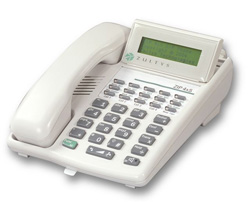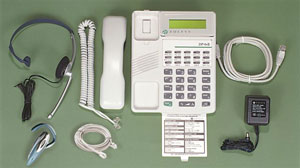Device Profile: Zultys Zip 4×5 VoIP phone for remote offices
Mar 25, 2004 — by LinuxDevices Staff — from the LinuxDevices Archive — 32 viewsVoIP hardware and software specialist Zultys Technologies has launched a new embedded Linux based phone for remote or home-office workers. The new Zip 4×5 incorporates a VPN router, firewall, and 4-port switch, as well as a normal analog phone for emergency calls. The 4×5 also supports Bluetooth, voice activated dialing, and other leading-edge features.

The Zip 4×5 has a business-phone look
According to Zultys, the Zip 4×5 is built exclusively on open standards and is compatible with any IP telephony system using SIP (Session Initiation Protocol). The device supports up to four simultaneous incoming or outgoing calls. Four RJ-45 ports provide local Ethernet LAN switching, and connect to a broadband modem. PCs connected to the phone can access the Internet and corporate network. The traffic on specified ports can be tunneled back to the corporate office, allowing devices in the home either complete access to the corporate network or access only to the Internet.
An RJ-11 provides an analog connection to the PSTN, which can be used for local and emergency calls.
According to Zultys, the Zip 4×5 appears as any other device on a company's PBX when used remotely. If a user has a phone in the corporate office and home office, the home office phone rings at the same time as the phone in the corporate office.
An optional Bluetooth wireless headset can be used to make and receive calls, and to control volume. Voice activated dialing supports dialing by name, keyword control of voicemail, and other features, permitting hands-free operation.

Complete Zip 4×5 package with optional Bluetooth headset
The phone retrieves its software and configuration from a TFTP server, or can be configured using an intuitive browser interface. Zultys claims administrators can provision the Zip 4×5 within minutes, whether it is located at the corporate office or at a remote site.
Additional features include:
- Ergonomic business phone design
- Buttons and keys for commonly used functions
- Multiple status LEDs (including message waiting)
- High contrast, tilting LCD
- Voice encryption for secure conversations, using Advanced Encryption Standard
- QoS at Ethernet and IP layers guarantees enough bandwidth for quality sound
- “Here I am” feature allows multiple guests to share a phone by logging in to receive calls to their extensions
- Power over Ethernet (PoE) according to the IEEE 802.3af standard
- Full duplex speaker phone with acoustic echo cancellation
- Five-way conferencing of inbound or outbound calls
- Access to the last 32 incoming and 32 outgoing calls
- Address book stores up to 100 entries
What's under the grill?
The Zultys 4×5 is based on an IBM 405GPr (PowerPC) processor. It boots from 16MB of flash memory, and runs in 32MB of SDRAM. Software can be downloaded onto the device remotely using TFTP. The bootcode, however, is fixed.

The Linux single board computer within
(Click to enlarge)
Zultys handled the Linux port in-house, according to Marketing VP Patrick Ferriter, because, “We feel it is critical to dedicate a team of engineers who thoroughly understand this operating system for development as well as maintenance.”
Zultys started with the freely available Linux PowerPC tree, and developed its Linux port using MontaVista's toolchain. The 4×5 runs a real-time Linux operating system based on a 2.4-series kernel with the preemptible kernel patches introduced by by MontaVista.
The phone does not have a hardware DSP (digital signal processor), instead relying on software running under Linux to provide conferencing, acoustic echo cancellation, speech compression, encrytion, and voice activated dialing.
The 4×5's SIP stack is from Hughes Software Systems (HSS) in India, which Zultys adapted to the PowerPC architecture. However, most of the core software was developed in-house by Zultys, according to Ferriter, to meet high performance requirements. For example, he says, “It is possible to use the speakerphone while having a conference call with four other parties in which some or all of those parties use G.729A speech compression, and the entire conference uses 128 bit AES encryption.”
Challenges and obstacles
Ferriter says that Bluetooth support presented the greatest technical challenge for Zultys. Many of the other device subsystems and applications had already been developed for Zultys's earlier Zip 4×4 phone, which shares the same OS, SIP stack, and most of the same DSP functions.
Zultys was able to use the normal Linux Bluetooth driver, but was challenged in understanding the requirements, selecting hardware, and undergoing compliance testing, according to Ferriter.
Why Linux?
Ferriter says Zultys chose to use Linux in its phones because of inhouse experience using Linux in other products, such as its PBX system. “Some manufacturers continue to use Windows on their products, which we do not feel is stable enough for communications applications. Others are using traditional real-time operating systems, and these would work very well for the phones. However, Zultys makes a range of other products that require the power brought by Linux, so it is a natural fit for us to use Linux inside the phone.”
Ferriter adds that the variety of mature, stable features provided by Linux was of benefit. “Linux is packed with 'goodies,'” he notes. “We use the included functions of PPPoE, Firewall, VPN, and NAT. These are all proven and highly stable.”
Ferriter predicts a bright future for Linux in embedded systems. “Real-time Linux will force suppliers of real-time operating systems to change their business model. For too long, these manufacturers have been too arrogant. Linux is constantly being refined by a whole community rather than a single enterprise. It will soon be the platform of choice for a significant portion of embedded applications.”
Availability
The Zip 4×5 is available in black or white, priced at $400 with software, ac adapter, headset, RJ11 cable, and Ethernet cable. A Bluetooth wireless headset brings the price to $450.
This article was originally published on LinuxDevices.com and has been donated to the open source community by QuinStreet Inc. Please visit LinuxToday.com for up-to-date news and articles about Linux and open source.